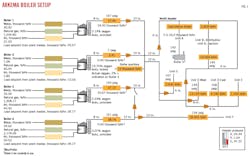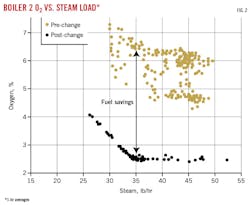Applied analytics improve performance of aging downstream assets
Zied M. Ouertani
ABB Automation GmBH
Mannheim, Germany
Global petrochemical capacity will experience major growth by 2025, with nearly 900 projects slated to begin production between now and then. While most growth will occur in the Asia Pacific and Middle East, North American investments are also on an upswing. This fresh capacity will likely exert price pressure on older plants’ abilities to remain competitive based on their major efficiency advantages.
Operators are evaluating options to improve performance of existing plants now to ensure they remain competitive. Failure to take these steps would force them to shut down plants and incur expensive liabilities to remediate the sites upon closure.
With global petrochemical manufacturers seeking to extend use of aging production assets beyond their expected lifespan and still deliver competitive performance, many operators are turning to digital solutions as a useful tool to assess low-capital options for getting more out of existing assets.
Implementation and application of analytics to improve decision making based on real-time data visualization can pinpoint and address problems hampering optimal performance and, when used as part of a condition-monitoring program, also help ensure gains are sustainable by alerting operators when things go off track.
This article presents two case studies in which ABB Ltd.’s implementation of digital solutions has reduced production costs and downtime, improved unit efficiencies, and slashed energy costs related to aging production equipment at petrochemical plants in Germany and the US.
Wacker Chemie AG
Despite smooth operations for 30 years, the operations management team at Wacker Chemie’s ketene-cracking plant in Burghausen, Germany, in Upper Bavaria, engaged ABB to help investigate how to boost efficiency of the site’s production system without replacing existing equipment.
At the Burghausen plant, liquid acetic acid is first evaporated and fed in a gaseous state into cracking furnaces that use special catalysts to separate the gas into water and ketene, which is used as a raw material to produce isopropenyl acetate and acetylacetone.
In a large plant with many different control loops, the loops often influence each other, and suboptimal control parameters can cause processes to fluctuate with negative effects on throughput and yield.
Control loops, however, are often only adjusted during a plant’s planning and engineering stages. Once the plant is operational, they are rarely reviewed. Even when production processes are changed, control loops often don’t automatically get updated. There also is frequently an underappreciation for the effect that aging and general wear-and-tear of control loops have on overall plant performance.
In addition to abolishing weak points and bottlenecks, control-loop optimization can improve component durability. Even minor changes to process can help plants run more closely to specification limits, increasing output and efficiency without negative impacts on production quality.
To that end, ABB delivered its loop-performance solution to conduct a comprehensive control-system performance analysis exploring the potential for improving control loops, control performance, and sensors. The technology allows services to be delivered remotely or on site, providing Wacker Chemie access to ABB’s most up-to-date system and process analysis functions. The system monitors signals on a continuous basis to generate key performance indicators (KPIs) that allow early fault detection and also presents data analytics graphically so operators can take appropriate action.
The Burghausen plant uses ABB’s Freelance process-control system with DigiVis to handle operation and observation functions. Necessary automation tasks are performed by five redundant AC 800F controllers, or rack-based process stations. A total of 139 control loops at the plant were inspected, including 109 loops studied in close detail. The loop-performance tool was connected to the process-control system via an OPC-DA interface, with a 2-sec signal sampling rate used to evaluate the performance of the plant’s control equipment.
The analysis revealed that some of the controllers needed to be changed into cascaded-loop control structures to deliver better control performance. The review gave plant operators greater awareness of the need to identify loops working less efficiently than projected and to inspect individual final-control elements.
The analysis revealed several other issues. For example, the loop-performance tool detected signal spikes without an obvious root cause. Further inspection revealed that long-invalid signals were still inadvertently in use. The investigation also discovered that missing setpoint-tracking values, or individual processing steps, were potentially compromising system performance in certain circumstances. The control system was also burdened with obsolete program modules. These findings resulted in measures to improve the plant’s overall process-control system.
By facilitating the continuous monitoring and visualization of KPIs, the operator cut its production costs by 20% and saved itself 35 days of analysis time annually, enabling it to move from a reactive maintenance regime to one which deploys predictive interventions based on the actual state of the equipment. Problems are now detected and fixed early, avoiding unnecessary capital and operational expenses.
Arkema Inc.
Digital solutions in the form of a fingerprint analysis have helped Arkema Inc. achieve more than $200,000/year in energy savings by identifying hardware and software improvements to optimize boiler operations at its chemical plant in Calvert City, Ky.
While industrial boilers are used as a steam source at many global refining and petrochemical plants, for many operators, the annual energy bill associated with this equipment runs into the millions to tens of millions of dollars. Arkema’s Calvert City plant site—which includes the world’s largest (hydrofluoro carbon) HFC-32 refrigerant production plant—houses four such boilers, producing steam at varying levels due to differences in size and date of installation (Fig. 1).
Steam-producing boilers use proportional–integral–derivative (PID) controllers to reduce product instability, regulate the process, and improve operations. In many cases, however, PID loops are not regularly maintained and, as a result, have degraded, hindering production and performance by negatively impacting operation of associated equipment.
Optimizing old and neglected PID loops can deliver large energy savings and better responses to process-steam demands as well as improved reliability and safety. It can also extend a boiler’s operating range.
ABB conducted a fingerprint analysis of the Calvert City plant’s four boilers to examine the condition of hardware and controls, test boiler stability and operation, perform combustion-load trials, and execute dynamic step response tests.
Two of the plant’s boilers were installed in 1952. They are brick-set with forced-draft (FD) intakes and induced-draft (ID) removal fans, each boiler rated at 40,000 lb/hr. The third boiler—a 1965 economizer equipped with only an FD fan—is rated at 75,000 lb/hr but was typically running at a maximum of 60,000 lb/hr. The fourth boiler, a 1996 economizer of the flue-gas recirculation variety, was operated in the same way as the third boiler.
Each of the four boilers was producing steam at around 165 psi but none were running at maximum capacity. ABB inspected each sequentially.
Fingerprint analysis began with the second boiler, as it was the most frequently used and least efficient.
Analysis revealed the boiler’s air flow and fuel-flow measurements were erratic, working against each other and creating variability. The boiler’s two oxygen sensors also read about 2% higher than a portable analyzer. A loose hatch door near the oxygen sensor was discovered to be leaking air into the ductwork before the ID fan. This leakage meant that air was being added, creating an oil flow that was not truly going into the boiler.
A furnace draft test suggested the leaked air was being sucked in by the ID fan and released from the stack as wasted energy. The ABB team found that the oxygen trim that finetunes the unit’s air-fuel ratio had been underused in recent years, leading to suboptimal operation.
Addtionally, the ID fan positioner’s movement was jerky, suggesting a potentially faulty pneumatic cylinder or piston assembly. The FD fan also had issues.
ABB further monitored control loops using Loopscan, revealing deficiencies that needed to be addressed (see accompanying table).
The fingerprint diagnostic review recommended improvements. On the hardware side, Arkema was advised to repair the FD and ID control drives; ensure adequate seals on all doors; and resolve oxygen-transmitter reading issues by checking the calibration, finding the leak, and changing location of the device. Other recommendations included recalibrating steam flows; adjusting, cleaning, or replacing the sight glass for the drum level; and adding blowdown-flow monitoring to facilitate removal of solid buildup originating from water and steam.
ABB also suggested that Arkema update the control logic to current implementation standards and perform a full-combustion test to finetune steam-to-air curves (especially for oil) while adjusting the logic to indicate when oil-gas is off. Updating the excess-air calculation was also recommended.
On the tuning front, recommendations included: retuning loops to be less aggressive, reducing output surge and ringing tendencies, adding a small filter to the level measurement to reduce feed-water chatter, and reducing the filter on old steam-flow measurement.
Following Arkema’s implementation of the recommended changes, oxygen readings were reduced to below 5% from a previous 6-7% (Fig. 3). The lower oxygen levels meant the boiler was drawing in less air, resulting in a fuel savings of around $75,000 for the second boiler alone without any major capital investment.
ABB repeated the analysis for the remaining boilers, with similar improvement areas identified. In the case of the third boiler, the analysis explained why the boiler tended to trip inexplicably during storms. The issue related to an FD fan with a roof intake, the exposed position of which generated errors since wind shear affected measurements from the Pitot tubes coming off the fan intake. A protective cover solved this problem. Results of the analysis further revealed that this boiler could safely operate at higher loads, enabling Arkema to maximize use of existing equipment.
Overall, the fingerprint analysis across the four boilers—which cost about $25,000 each—resulted in an ongoing annual energy savings of about $237,000.
The author
Dr. Zied M. Ouertani ([email protected]) is digital lead of chemicals and refining for ABB Ltd.’s oil, gas, and chemical’s business unit, where he globally oversees digitalization of the chemicals and refining industries. Joining ABB in 2012, Ouertani also has served as the company’s principal scientist in corporate research and as a business consultant for corporate strategy. He previously worked at the University of Cambridge, UK, as a post-doctoral research and business transformation consultant. Ouertani holds a PhD (2007) in information systems from Université Henri Poincaré, Nancy, France, and an MS (2003) in production automation from École Normale Supérieure de Cachan, France.




